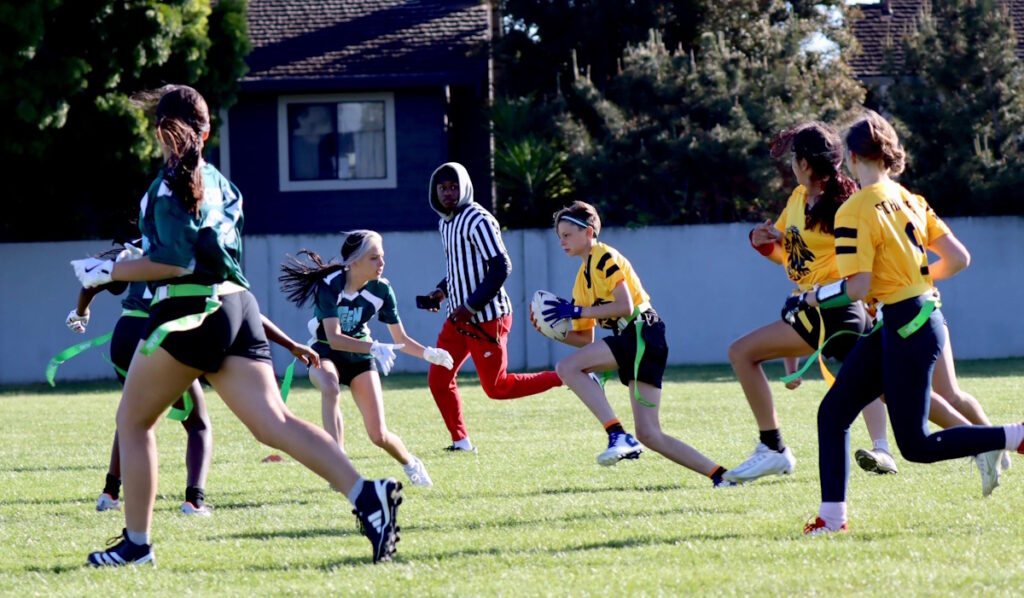Local, Homegrown Organization To Wrap Up Year In Championship Showdown on May 31
By Larry Freeman

What will become the last hurrah, and championship games for the inaugural season of Alameda’s middle school flag football league, became a settled matter in two playoff games held on Sunday and Wednesday May 19 and 22.
In the Co-Ed League, the Wood Beavers ranked #1 and the West Alameda Hellcats ranked #2.
The Girls’ League finished with the Lincoln Lions at #1 and the Lincoln Wildcats at #2.
The girls’ league will pit its top two teams against each other at its championship game May 31, at Wood Middle School, at 5:00 pm.
The co-ed championship game will unfold at Lincoln Middle School, Saturday, June 1, at 8:50 am.
The Beavers swept their conference his season, losing only in a cross-league game against the Steelers, an Oakland travel team.
The Beavers squad had pre-league ties and chemistry as most of them played together, recreationally, before they formed the Wood team.
Some of the players on the Beavers, along with a few Olympians and Steelers, previously trained together with East Bay Flag Football, which ended its Alameda operations in 2023.
The Hellcats, on the other hand, were generally new to each other this season.
The team united Nea and Encinal students under Coach Daniel Hudson, as there were not enough players at either school to field a team, and rounded out the team with two Academy Of Alameda (A0A) students.
The Hellcats squeaked in at #2 by defeating the #4 Olympians, composed of A0A students, last week.
The Lincoln Lions have a tied record with the Olympians, each winning one game against the other by a score of 26-20.
“These guys play together on the playground every day,” says Olympians parent Jenny Seiler.
“Playing against another school heightens that camaraderie, though. Combine that with the development and growth of a league sport, and we get a more meaningful connection to the game and the kids that play it. It has more of a story arc,” she said.

Despite the impending closure of their middle school, the Bay Farm Dolphins took to the turf this season as well. Most of the teammates play baseball together, and wanted to try taking the same band into a revitalized sport that is taking the nation and even the globe by storm.
The girls’ Lincoln Lions came together around a couple of Lincoln basketball players with flag football league experience, their friends who wanted to try the new sport, and Coach Stef Szczechowski, who also runs Alameda Women’s Flag Football League. The Lions went undefeated in their conference.
The Beavers’ Brady Olson and Olympians’ Rajaun Lewis played tackle ball last fall, but enjoy having a flag league to keep their skills up in the spring.
The creation of the Alameda League began amidst a middle school hosted drought of teams and leagues, in an era where AUSD cut its competitive sports programs, leaving only the high schools to host them.
In that vacuum, various community based and (pay to play, for profit) club teams rose up to fill the public or private school gap.
Given the greater ease to organize, host and equip youngsters to play the game, compared to traditional football, the opportunity was open for local inspiration and leaders to open up the field to give kids a chance to participate in the revival of a vigorously up-trending sport, that is taking the nation (again) by storm.
The International Federation of American Football reports that 2.4 million kids under 17 are playing organized flag football in the U.S., while millions more participate in flag globally.
The resurgence of flag football represents a kind of history repeats itself, blast from the past story with deep national roots.
Flag football, an American innovated variant of rugby and US style tackle football, traces back to the World War II era when U.S. military personnel adapted the old school, rough and tumble grid iron gam into one where physical contact –and consequent, potential injury– was minimized and with the game made playable without the cost and encumbrances of equipment needed in traditional American football.
Adding the skill of having to pull one of two flags tucked in on either side of the player’s waste, imposed a higher level of skill needed to end the motion of the ball carrier and pursuing player(s).
It gave greater advantage to the runner, with flags flapping in varied motions, or hips strategically rotating for evasiveness, than what existed in flag’s predecessor, ‘touch football.’ In that incarnation, merely making contact with any part of the runner’s body would end the forward movement of the runner.

The Alameda Flag Football program also offers folks in the community to form their own ‘pick up’, ‘do it yourself’ opportunities to keep the ball moving and flags flying after the league season and championships are ended for the year.
Its website states its central mission –outside of just bringing the game home here. “ Mostly, we just like to have our teams play games off-season and outside of whatever organized leagues we put them in.
We also offer a combine in March for coaches, their teams, and prospective new players.”
Towards that end , its website, https://www.alamedaflagfootball.com/home provides a cost based ‘how to get a game or games going’ in the “Coaches’ co-op” segment found atop the nav bar.
(Photos provided by Alameda Flag Football. Travis Wilson is League Commissioner and a key founder of the program, and his leadership and efforts, along with key volunteer help and community spirit have brought this new opportunity to town to help fill the Middle School sports gap.)
